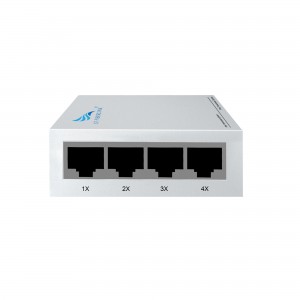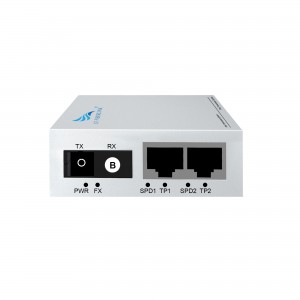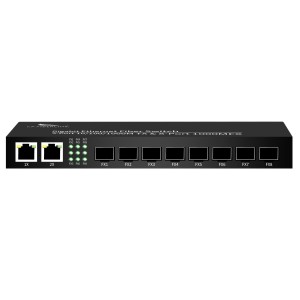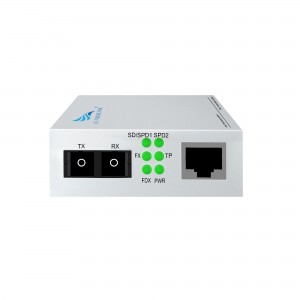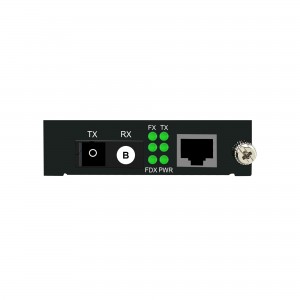10-port 10/100/1000M WDM Media Converter (Single-mode Single-fiber SC)
10-port 10/100/1000M WDM Media Converter (Single-mode Single-fiber SC)
Product Features:
Huizhou Changfei Optoelectronics Technology Co., Ltd. launched a compact optical fiber transceiver Gigabit 8-optical 2 electrical single-mode single-fiber open switch optical fiber transceiver. As a leading innovator of 5G communication equipment, 10M core switches and industrial Ethernet cloud-level managed switches, we are proud to launch this revolutionary product that will change your network experience.
Imagine a world where connections are seamless, reliable, and lightning fast. With our Gigabit 8-optical 2-electrical single-mode single-fiber media converters, this vision becomes a reality. Designed to meet the growing demands of today’s businesses and tech-savvy individuals, this cutting-edge solution combines advanced technology with convenience.
This media converter has an SC interface to ensure a stable and secure connection. Dynamic LED indicators allow easy monitoring to easily identify any network issues and ensure optimal performance. With its plug-and-play functionality, setup and operation of the converter is a breeze, saving you time, energy and frustration.
One of the outstanding features of this gigabit media converter is its compact size. We know that space is a precious resource, especially in crowded network environments. That’s why we designed this converter to be as small as possible without compromising its excellent functionality. Its sleek design allows for discreet installation, making it ideal for office environments and home networks.
The media converter adopts a single-mode single-fiber open switch, which can provide long-distance high-speed data transmission, and the transmission distance can reach 20 kilometers. This ensures your network stays connected no matter the size or layout of your space. Whether you’re transferring large files, conducting video conferencing, or managing multiple devices simultaneously, this converter can handle it all.
At Huizhou Changfei Optoelectronics Technology Co., Ltd., we pride ourselves on our commitment to quality and reliability. Our products are rigorously tested to the highest industry standards, ensuring you are getting the best product possible. With our extensive experience in the field, we have built a reputation for delivering innovative solutions that enhance connectivity and streamline operations.
In today’s fast-paced world, staying connected is no longer a luxury but a necessity. With our Gigabit 8 Optical 2 Electrical Single Mode Single Fiber Media Converters you can take control of your network and unlock its true potential. Experience the power of seamless connectivity and unrivaled performance – choose the best, choose Huizhou Changfei Optoelectronics Technology Co., Ltd.
Upgrade your network capabilities today and join the growing list of satisfied customers who trust us for their connectivity needs. Increase efficiency, save time, and unlock endless possibilities with our compact Fiber Media Converter Gigabit 8 Optical 2 Electrical Single Mode Single Fiber Open Frame Optical Transceiver. Let’s redefine how we connect.
Technical Parameter:
|
Model |
CF-8012GSW-20B | |
| Interface Characteristics | ||
|
Fixed Port |
2* 10/ 100/ 1000Base-T RJ45 port 8* 1000Base-X uplink SC fiber port |
|
|
Ethernet Port |
10/ 100/ 1000Base-T auto-sensing, full/half duplex MDI/MDI-X self-adaption |
|
|
Twisted Pair Transmission |
10BASE-T: Cat3,4,5 UTP(≤100 meter) 100BASE-T: Cat5e or later UTP(≤100 meter) 1000BASE-T : Cat5e or later UTP(≤100 meter) |
|
| Optical Port | Default optical module is single-mode single-fiber 20km, SC port | |
| Wavelength/Distance | A-end: RX1310nm / RX1550nm 0 ~ 40KM
B-end:RX1550nm/ RX1310nm 0 ~ 40KM |
|
| A-end: RX1490nm / RX1550nm 0 ~ 120KM
B-end:RX1550nm/ RX1490nm 0 ~ 120KM |
||
| Chip Parameter | ||
| Network Protocol | IEEE802.3 10BASE-T, IEEE802.3i 10Base-T,
IEEE802.3u 100Base-TX, IEEE802.3u 100Base-FX, IEEE802.3x IEEE802.3ab 1000Base-T;IEEE802.3z 1000Base-X; |
|
|
Forwarding Mode |
Store and Forward(Full Wire Speed) |
|
|
Switching Capacity |
20Gbps |
|
|
Buffer Memory |
14.88Mpps | |
|
MAC |
2K | |
|
LED Indicator |
Fiber | FX1-FX8 |
| On the RJ45 seat | 1X-2X Yellow:Indicate PoE | |
| 1X-2X Green: Indicates network working status | ||
| Power | PWR (green) | |
| Power | ||
| Working Voltage |
AC:100-240V |
|
|
Power Consumption |
Standby<3W, Full load<10W |
|
|
Power Supply |
DC:5V/2A industrial power supply |
|
| Lightning protection &Certification | ||
| Lightning protection | Lightning protection: 4KV 8/20us, Protection level: IP30 | |
| Certification | CCC;CE mark, commercial; CE/LVD EN60950;FCC Part 15 Class B; RoHS | |
| Physical Parameter | ||
| Operation TEMP | -20~+55°C;5%~90% RH Non condensing | |
| Storage TEMP |
-40~+85°C;5%~95% RH Non condensing |
|
| Dimension (L*W*H) | 220mm* 101mm*28mm | |
| Installation | Desktop | |
Product Size:
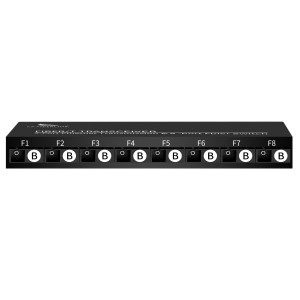
product application diagra:

How to choose a fiber optic transceiver?
Optical fiber transceivers break the 100-meter limitation of Ethernet cables in data transmission. Relying on high-performance switching chips and large-capacity caches, while truly achieving non-blocking transmission and switching performance, they also provide balanced traffic, isolation and conflict. Error detection and other functions ensure high security and stability during data transmission. Therefore, fiber optic transceiver products will still be an indispensable part of actual network construction for a long time. So, how should we choose fiber optic transceivers?
1. Port function test
Mainly test whether each port can work normally in the duplex state of 10Mbps, 100Mbps and half-duplex state. At the same time, it should be tested whether each port can automatically select the highest transmission speed and automatically match the transmission rate of other devices. This test can be included in other tests.
2. Compatibility test
It mainly tests the connection ability between the optical fiber transceiver and other devices compatible with Ethernet and Fast Ethernet (including network card, HUB, Switch, optical network card, and optical switch). The requirement must be able to support the connection of compatible products.
3. Cable connection characteristics
Test the fiber optic transceiver’s ability to support network cables. First, test the connection ability of Category 5 network cables with lengths of 100m and 10m, and test the connection ability of long Category 5 network cables (120m) of different brands. During the test, the optical port of the transceiver is required to have a connection capability of 10Mbps and a rate of 100Mbps, and the highest must be able to connect to a full-duplex 100Mbps without transmission errors. Category 3 twisted pair cables may not be tested. Subtests can be included in other tests.
4. Transmission characteristics (transmission loss rate of data packets of different lengths, transmission speed)
It mainly tests the packet loss rate when the optical fiber transceiver optical port transmits different data packets, and the connection speed under different connection rates. For the packet loss rate, you can use the test software provided by the network card to test the packet loss rate when the packet size is 64, 512, 1518, 128 (optional) and 1000 (optional) bytes under different connection rates. , the number of packet errors, the number of packets sent and received must be more than 2,000,000. Test transmission speed can use perform3, ping and other software.
5. The compatibility of the whole machine to the transmission network protocol
It mainly tests the compatibility of fiber optic transceivers to network protocols, which can be tested in Novell, Windows and other environments. The following low-level network protocols such as TCP/IP, IPX, NETBIOS, DHCP, etc. must be tested, and the protocols that need to be broadcast must be tested. Optical transceivers are required to support these protocols (VLAN, QOS, COS, etc.).
6. Indicator status test
Test whether the status of the indicator light is consistent with the description of the panel and the user manual, and whether it is consistent with the current status of the fiber optic transceiver.








